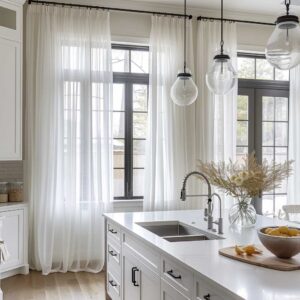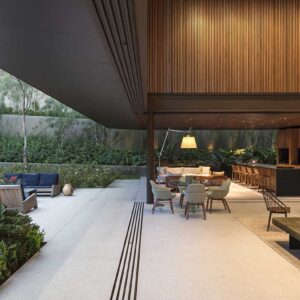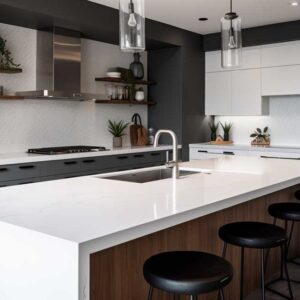In the world of interior design, the kitchen is a focal point of daily life, a place where functionality meets personal style. With the rise of minimalist decor, the challenge of incorporating this sleek, uncluttered aesthetic into smaller spaces has become a popular endeavor. Embracing the principles of minimalism in a compact kitchen not only enhances the illusion of space but also focuses on the harmony between form and function. This approach to design emphasizes the beauty of simplicity, clean lines, and a monochromatic color palette, all while ensuring every element serves a purpose. Discover how you can transform your limited kitchen area into a minimalist masterpiece with these trend-setting ideas.
Minimalist Decor for Compact Spaces




In the realm of interior design, the concept of minimalism has steadily ascended to the forefront, especially within the constraints of short kitchen design. This approach is not merely about reducing items to their bare essentials but creating a space that combines functionality with serene aesthetics. The minimalist kitchen, particularly in smaller homes or apartments, embodies efficiency, simplicity, and elegance.
The cornerstone of this design philosophy lies in the clever use of space and light. By prioritizing a clean, uncluttered layout, the kitchen appears more extensive and welcoming. The use of sleek countertops, devoid of unnecessary items, accentuates this feeling of openness. Materials play a critical role here; natural elements like wood for the flooring or stone for the countertops introduce a subtle warmth, countering the sterility often associated with minimalism.




Color schemes tend to lean towards whites and greys, which serve to amplify the natural light within the room. Strategic placement of LED lighting under cabinets not only enhances functionality but also adds to the ambiance, creating a cozy yet modern feel. A singular piece of art or a vibrant plant can serve as a focal point, injecting personality and life into the space without overwhelming it with visual clutter.
The beauty of minimalist design in short kitchens lies in its acknowledgment of the kitchen’s dual role as a place of preparation and a space for gathering. By focusing on essential functionalities and aesthetic simplicity, the minimalist kitchen becomes a tranquil haven, reflecting the homeowner’s values and lifestyle.
Short Kitchen Design with Hidden Functionalities
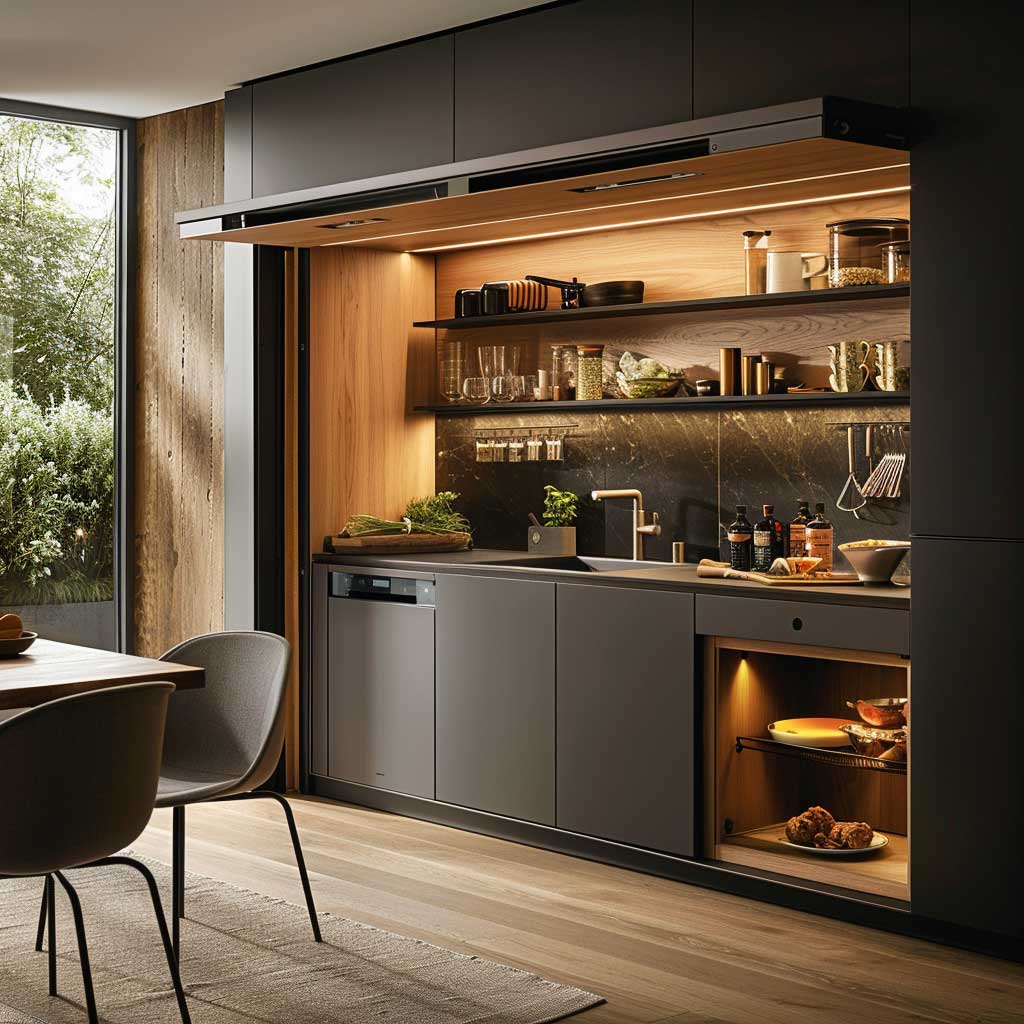

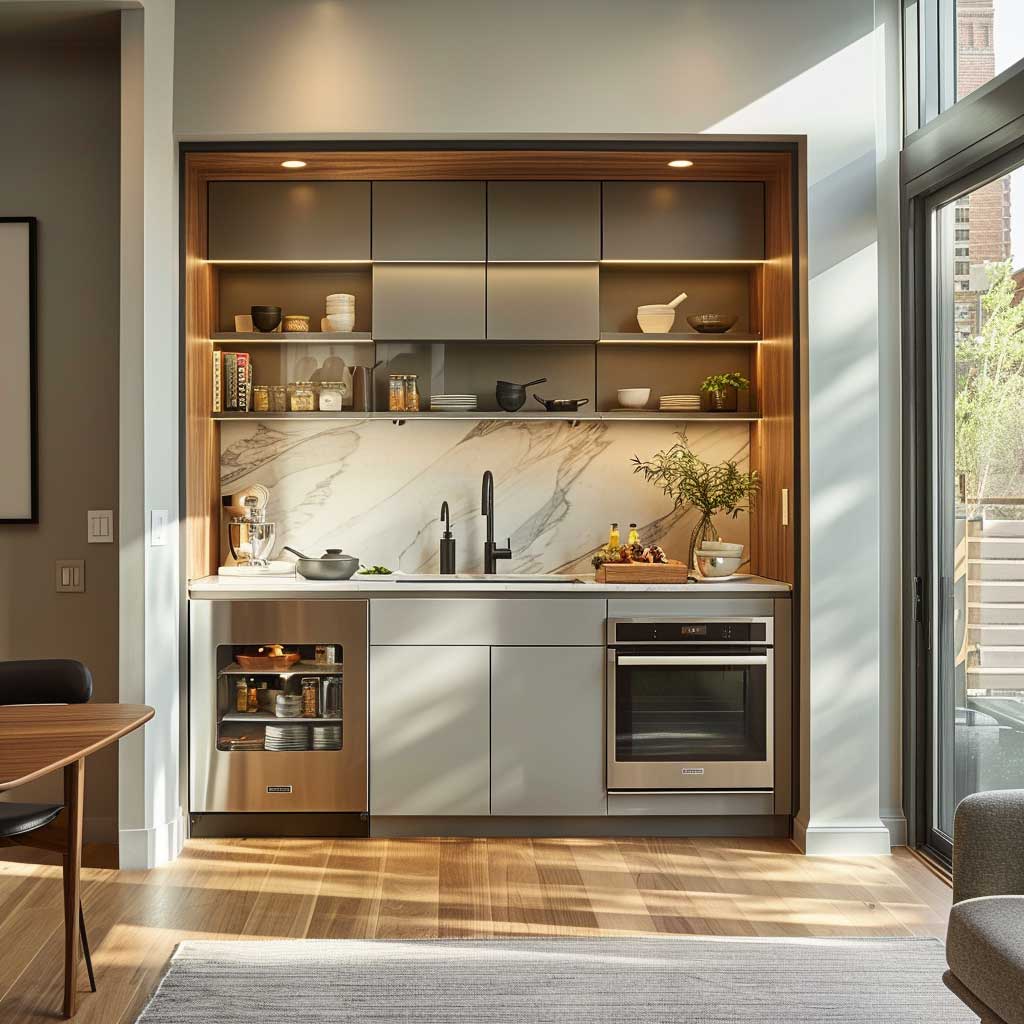

Innovative solutions are the heart of short kitchen design, especially when imbued with a minimalist ethos. The challenge of maintaining a sleek, unobtrusive aesthetic while incorporating necessary functionalities is met with creative design solutions. One such approach is the integration of hidden features that serve multiple purposes, enhancing both utility and visual harmony.
The essence of this design strategy is apparent in kitchens where appliances seamlessly blend into the surroundings. Concealed storage options, such as retractable drawers and cabinets flush with the walls, contribute to a clutter-free environment. A notable feature in these kitchens is the transformative furniture – a countertop that extends to become a dining area, embodying the minimalist principle of form following function.




Color and material selection are carefully considered to maintain a cohesive look. Cabinetry in muted tones merges with the overall color scheme, visually expanding the space. Contrasting this, the flooring might adopt a slightly darker hue, grounding the design without overpowering the minimalist aesthetic. The absence of traditional hardware, replaced by touch-to-open mechanisms, emphasizes clean lines and simplicity.
This approach to short kitchen design is not just about aesthetic appeal; it’s a reflection of a lifestyle choice that values efficiency and simplicity. By integrating multifunctional elements, the kitchen remains a place of culinary creativity without sacrificing its minimalist charm.
Airy and Light Short Kitchen Design




Creating an airy and light atmosphere in a short kitchen design requires a keen understanding of how to manipulate space and color. In minimalist kitchens, where the aim is to create a sense of openness and tranquility, particular attention is paid to maximizing natural light and enhancing airflow. This design philosophy transforms small kitchens into spaces that feel expansive and vibrant.
The use of open shelving and glass-front cabinets plays a significant role in achieving this effect. By minimizing visual barriers, these elements encourage the eye to travel through the space, making the kitchen appear larger. The choice of a monochromatic color scheme, predominantly in whites or light pastels, reflects natural light, further amplifying the sense of openness. Strategic placement of windows, especially narrow ones that stretch upwards, allows for ample light without sacrificing precious wall space for storage or appliances.




Flooring choices also contribute to the airy feel of the kitchen. Light wood tones not only add warmth to the space but also enhance the natural light, creating a soft, inviting glow. The inclusion of a bold green plant introduces a burst of color, breaking the monotony and bringing a piece of the outside world in.
This minimalist approach to short kitchen design is more than just an aesthetic choice; it’s about creating a space that feels open, clean, and calm. It’s a kitchen where every element has been thoughtfully considered to enhance the overall experience of cooking and socializing, proving that even the smallest kitchens can be transformed into beautiful, functional spaces.
Adopting minimalist trends in kitchen design offers more than just an aesthetically pleasing environment; it promotes an uncluttered lifestyle that values simplicity and efficiency. By focusing on essential elements and discarding the superfluous, small kitchens can be transformed into elegant and highly functional spaces. The trend encourages creativity in the use of space, clever storage solutions, and the selection of colors and materials that reflect light, making the kitchen feel larger and more welcoming. As we move forward, the minimalist approach in kitchen design continues to evolve, proving that even the smallest spaces can offer big possibilities for style, comfort, and practicality.


